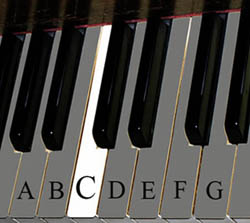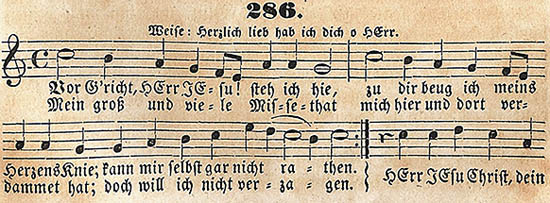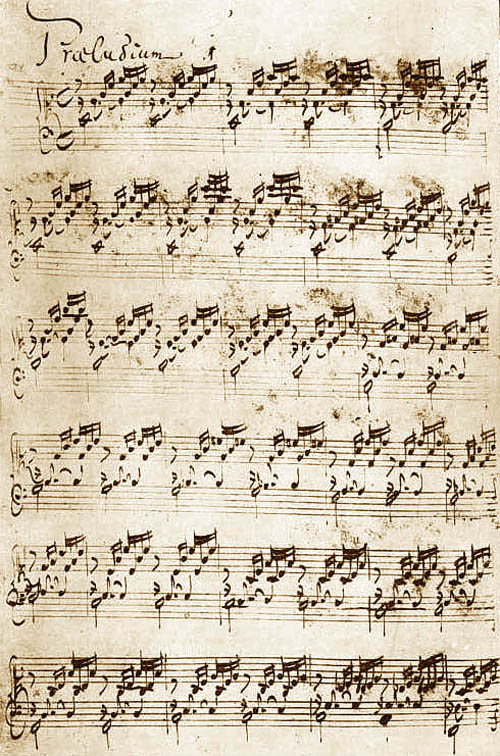In C
by Roger Kaza
Today, French hornist Roger Kaza plays in C. The University of Houston's Music School presents this program about the machines that make our civilization run, and the people whose ingenuity created them.
[Three notes from Also Sprach Zarathustra]
Do you remember those three notes at the beginning of the film 2001? They're practically a cliché. But what about the note that comes before? I'm talking about that low rumble, which, if you hear it in context, lasts about 20 seconds. It's 20 long seconds in which the composer, Richard Strauss, chose to select just one pitch to represent Nature, a primordial hum of the cosmos. For someone with Strauss' ear, there was an obvious candidate: a note on the pedal organ vibrating 16 times per second. That's a very low C. [Zarathustra pedal note]
 And if you took piano lessons as a child, the first note you ever learned was the one right in the center of the keyboard. That's middle C. If you kept at it, you eventually played the first of Bach's 48 preludes and fugues, which starts on middle C. [Opening of 1st Bach prelude]
And if you took piano lessons as a child, the first note you ever learned was the one right in the center of the keyboard. That's middle C. If you kept at it, you eventually played the first of Bach's 48 preludes and fugues, which starts on middle C. [Opening of 1st Bach prelude]
And if you have ever been to the opera, or even heard of the soprano and the tenor's histrionic triumphs and tragedies, you know the note that they simultaneously fear and exult. That's their high C. [High C by Pavarotti in La fille du Regiment]
How can one note have such a reputation? Actually, the musical alphabet begins with C. It's the key signature with no sharps or flats, the white keys on the piano. Some have even called it the "white" key. Others were more effusive. In 1806 the poet and music theorist Christian Schubart wrote a treatise defining the characteristics of different keys. C major, he wrote, was "completely pure." Its character is: "innocence, simplicity, naïveté, children's talk." His opinion may be partly because up until about the middle of the 19th century, keyboard instruments were tuned in an unequal way that favored some keys over others. The most favored key of all: C major.

An old melody, firmly anchored in C. From an 1851 German hymnal
Of course, there are eleven other notes in the western musical scale, and so eleven other keys in which to write music. Composers develop unique and highly personal relationships with musical keys. For Beethoven, E flat major was the key of heroism; as in his Eroica Symphony. For Brahms, E flat minor was reserved for the blackest of sorrows. Would we stand up for the Hallelujah Chorus were it not set in the triumphant key of D? And Mozart's sunniest, most untroubled, key: A major.
But C, what is it about C? The California composer Terry Riley began the minimalist movement in 1964. Minimalism now permeates much of contemporary music -- John Adams, Steve Reich and Philip Glass. Riley led his listeners on a ramble through subtly evolving rhythms. But his piece was defined by that single, dominating key. And he named his composition exactly what it was: In C.
I'm Roger Kaza, at the University of Houston, where we're interested in the way inventive minds work.
In the opening of Strauss' Also Sprach Zarathustra, used in Kubrick's 2001, three other instruments join the organ, pianissimo: contra-bassoon, and double bass and bass drum, both playing tremolo. The organ probably doubled the octave at 33 Hz as well. On a serendipitous note, I was astonished to learn recently that the so-called Schumann resonance, an extremely low frequency (ELF) generated by the cavity between the earth and the atmosphere, resonates in the vicinity of 8 hz, which is a slightly flat C an octave below the one which begins Zarathustra and too low to be sensed by the human ear.
There are, needless to say, far more musical "C"s than the three mentioned above. Click here for a frequency chart of different notes, all based on standard A = 440 Hz.
Click here for the New York Times article, The note that makes us weep.
Click here for Christian Schubart's Theory of Key Affects.
Here is an interesting discussion of musical temperament.
Riley's work is discussed in a Wikipedia article.
Roger Kaza is an Assistant Professor of Horn at the Moores School of Music, University of Houston. He is also Associate Principal Horn of the Houston Symphony, and Principal Horn of the Chautauqua Symphony at the historic Chautauqua Institution in upstate New York. He has appeared as a soloist with many orchestras in the United States, Canada and Mexico, and has lectured and performed for the International Horn Society. Kaza has made a specialty of investigating the natural acoustics of western canyons, and played his horn in Grand Canyon, Santa Elena Canyon, Black Canyon, and many others.
Musical Example credits:
1. Opening Trumpet Notes: John DeWitt, Anthony Prisk, Houston Symphony Trumpets
2. Richard Strauss, Zarathustra Pedal Point: Bernard Haitink, Royal Concertgebouw Orchestra
3. Bach Prelude No. 1 in C: Glenn Gould, piano
4. Donizetti, La fille du régiment: "Ah mes amis - Pour mon âme," Luciano Pavarotti & Richard Bonynge, Chorus of the Royal Opera House, Covent Garden
5. Terry Riley In C: re-sound

Manuscript page of Bach's Prelude In C. "In the beginning…" Bach's monumental 48 Preludes and Fugues, which start on middle C, are often referred to as the "Old Testament" of piano repertoire, with Beethoven's 32 Sonatas being the New. Note the top staff is in the archaic soprano clef, where middle C is the bottom line.